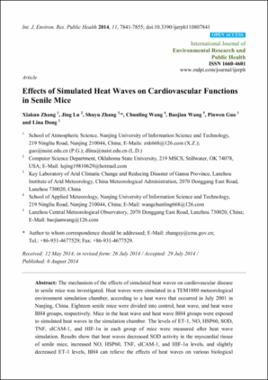| dc.contributor.author | Zhang, Xiakun | |
| dc.contributor.author | Lu, Jing | |
| dc.contributor.author | Zhang, Shuyu | |
| dc.contributor.author | Wang, Chunling | |
| dc.contributor.author | Wang, Baojian | |
| dc.contributor.author | Guo, Pinwen | |
| dc.contributor.author | Dong, Lina | |
| dc.date.accessioned | 2019-09-25T18:24:46Z | |
| dc.date.available | 2019-09-25T18:24:46Z | |
| dc.date.issued | 2014-08-06 | |
| dc.identifier | oksd_zhang_effectsofsimula_2014 | |
| dc.identifier.citation | Zhang, X., Lu, J., Zhang, S., Wang, C., Wang, B., Guo, P., & Dong, L. (2014). Effects of simulated heat waves on cardiovascular functions in senile mice. International Journal of Environmental Research and Public Health, 11(8), 7841-7855. https://doi.org/10.3390/ijerph110807841 | |
| dc.identifier.uri | https://hdl.handle.net/11244/321448 | |
| dc.description.abstract | The mechanism of the effects of simulated heat waves on cardiovascular disease in senile mice was investigated. Heat waves were simulated in a TEM1880 meteorological environment simulation chamber, according to a heat wave that occurred in July 2001 in Nanjing, China. Eighteen senile mice were divided into control, heat wave, and heat wave BH4 groups, respectively. Mice in the heat wave and heat wave BH4 groups were exposed to simulated heat waves in the simulation chamber. The levels of ET-1, NO, HSP60, SOD, TNF, sICAM-1, and HIF-1a in each group of mice were measured after heat wave simulation. Results show that heat waves decreased SOD activity in the myocardial tissue of senile mice, increased NO, HSP60, TNF, sICAM-1, and HIF-1a levels, and slightly decreased ET-1 levels, BH4 can relieve the effects of heat waves on various biological indicators. After a comprehensive analysis of the experiments above, we draw the followings conclusions regarding the influence of heat waves on senile mice: excess HSP60 activated immune cells, and induced endothelial cells and macrophages to secrete large amounts of ICAM-1, TNF-a, and other inflammatory cytokines, it also activated the inflammation response in the body and damaged the coronary endothelial cell structure, which increased the permeability of blood vessel intima and decreased SOD activity in cardiac tissues. The oxidation of lipoproteins in the blood increased, and large amounts of cholesterol were generated. Cholesterol penetrated the intima and deposited on the blood vessel wall, forming atherosclerosis and leading to the occurrence of cardiovascular disease in senile mice. These results maybe are useful for studying the effects of heat waves on elderly humans, which we discussed in the discussion chapter. | |
| dc.format | application/pdf | |
| dc.language | en_US | |
| dc.publisher | MDPI | |
| dc.rights | This material has been previously published. In the Oklahoma State University Library's institutional repository this version is made available through the open access principles and the terms of agreement/consent between the author(s) and the publisher. The permission policy on the use, reproduction or distribution of the material falls under fair use for educational, scholarship, and research purposes. Contact Digital Resources and Discovery Services at lib-dls@okstate.edu or 405-744-9161 for further information. | |
| dc.title | Effects of simulated heat waves on cardiovascular functions in senile mice | |
| osu.filename | oksd_zhang_effectsofsimula_2014.pdf | |
| dc.description.peerreview | Peer reviewed | |
| dc.identifier.doi | 10.3390/ijerph110807841 | |
| dc.description.department | Computer Science | |
| dc.type.genre | Article | |
| dc.type.material | Text | |
| dc.subject.keywords | heat wave weather | |
| dc.subject.keywords | senile mice | |
| dc.subject.keywords | hsp60 | |
| dc.subject.keywords | sod | |
| dc.subject.keywords | tnf | |
| dc.subject.keywords | sicam-1 | |
| dc.subject.keywords | atherosclerosis | |
